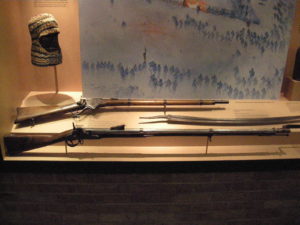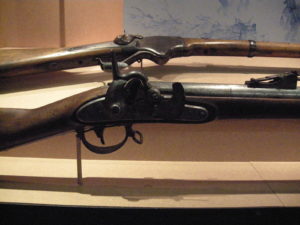“I do not know of an occasion when the assaulting force was so totally annihilated” – Captain Orlando M. Poe, Official Records of the War of the Rebellion, Vol. 31
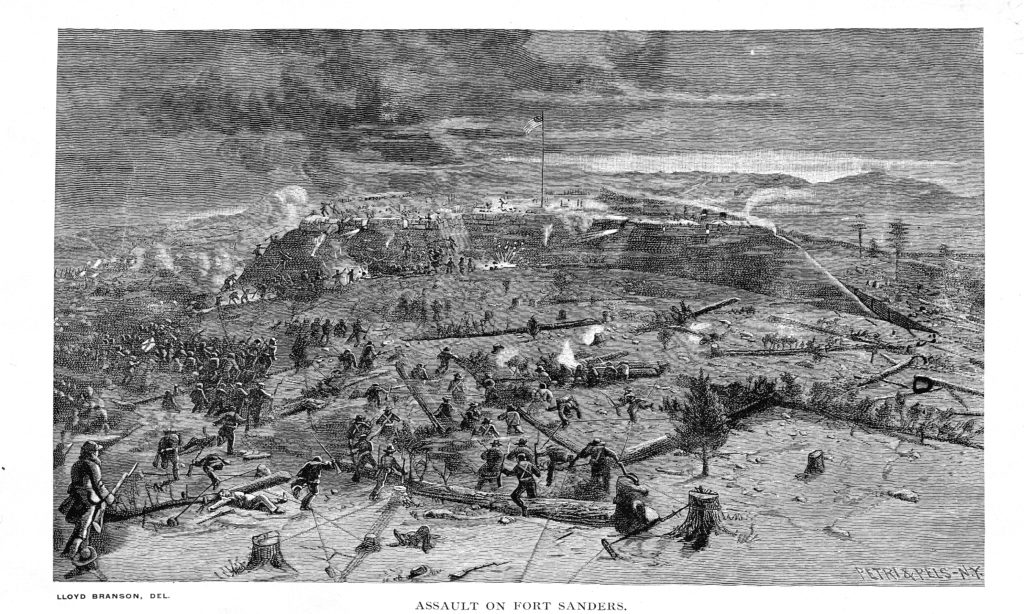
THE ASSAULT ON FORT SANDERS, 1888 Original in Thomas Humes’ book Loyal Mountaineers of Tennessee. Lloyd Branson, a well-known East Tennessee artist, created many fine works using local sites and individuals as his subject material.
The assault on Fort Sanders can justly be called an action of last resort. Attempts to take Knoxville from the south and west had failed, and both the northern and eastern approaches had been considered and rejected as unassailable. The ten-day-old siege was doomed to fail; while the Union army was hungry, enough food was coming in from loyalists in the countryside. Into the stalemate rode an officer from Chattanooga with a message from Braxton Bragg: Attack and return!
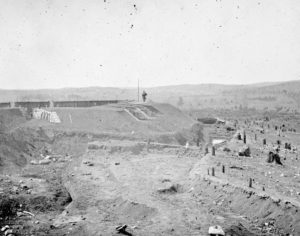
FORT SANDERS, NORTHWEST BASTION March 1864 Original in the Library of Congress “There are boots over the hill, boys,” General Archibald Gracie of Alabama told his troops massed as part of the never-called second wave of the assault. The amazing combination of additional defense elements initiated by Capt. Orlando Poe compensated for the weaknesses of the fort. Longstreet called off the attack after only 20 minutes. Note the stumps and ditch in front and the sandbags and barrels near the cannon. The view is to the west.
The long-anticipated attack came at first light on November 29, 1863. The temperature was below freezing and a thick, white fog blanketed the area. All element of surprise had been lost the night before when the rifle pits in front of the fort were taken by Longstreet’s sharpshooters. A 20-minute artillery barrage by the Confederates preceded the bayonet charge, and 4,000 cold soldiers charged up the hill into the guns of some 200 defenders, which had risen to about 440 by the end of the assault.
The pointed branches and telegraph wire broke the organization of the charge, but it was the ditch that ended it. Once the men were inside the ditch, advance or retreat was impossible. There were no scaling ladders or tools for cutting footholds into the 20-foot ice-covered wall. Lt. Samuel Benjamin, 2nd U.S. Artillery, threw lighted Hotchkiss shells over the top of the fort into the ditch, which quickly filled with the dead and dying. Three regimental flags planted on the parapet were quickly captured by soldiers inside.
At the rear of the action, Longstreet received an inaccurate report from a trusted soldier that the wire entanglement was impassible. He called a retreat which he later wrote he regretted. It was all over in 20 minutes. The simple frontal assault by the best, longest-serving troops of the Confederacy, veterans of Fredericksburg, Gettysburg, and Chickamauga, who outnumbered the defenders almost 10 to 1, was stopped dead.
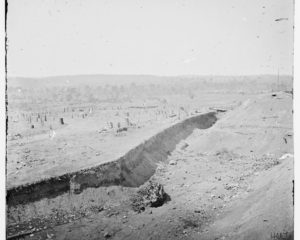
FORT SANDERS, NORTHWEST BASTION March 1864 Original in the Library of Congress As part of one of the most complete contemporary documentations of a battle, in March 1864, Poe enlisted the talents of Army photographer George Barnard to capture the details of the terrain of the assault. The view is to the north.
Burnside offered a truce. Both sides attended to the dead and wounded and exchanged prisoners. Casualties totaled 813 Confederate dead and wounded, 13 on the Union side. At 7 PM the truce ended, and both armies returned to their lines, the ‘defeated’ Confederates resuming the siege of the ‘victorious’ Federals.
Longstreet now aware of Bragg’s defeat in Chattanooga, stayed until December 4, when he got word that Union General William T. Sherman had arrived in Maryville with 25,000 Union reinforcements. The Confederates wintered in East Tennessee, making several unsuccessful attempts to attack Knoxville again. Longstreet’s army rejoined Gen. Robert E. Lee in Virginia in April.
Up Next:John Watkins, Eye Witness
SPENCER RIFLE, 1863 (top)
Steel, Walnut
Gift of the heirs of Frank W. Taylor and Mrs, W.W. Harrell, 1951
The Spencer rifle, the primary repeating rifle used by the Union forces is a 7-shot repeater. The .52-caliber brass bullet was rim fired and was the first self contained metallic cartridge powerful enough for military use. Several rounds were loaded in the buttstock and advanced to the firing mechanism.
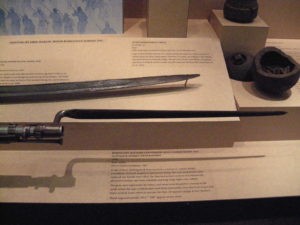
CALVARY SWORD BLADE, 1840 (center)
Civil War Era
Loaned by Richard Polehmus
Contemporary Reports state that officers used swords to dig hand-holds in the icy walls of Fort Sanders in an attempt to reach the top of the parapet. The blade was recovered from the slope in front of Fort Sanders during the construction of a parking garage in the 1950s.
REMINGTON MAYNARD CONVERSION OF 69-CALIBER MODEL 1816 FLINTLOCK MUSKET WITH BAYONET, 1850s (bottom)
Steel, walnut. Gifts of David Creekmore, 1987
Hand-engraved initials “ALC” and “MR” appear on the stock.
In the 1850s, E. Remington & Sons received a contract to convert 20,000 smoothbore flintlock muskets to percussion firing. The lock mechanisms were replaced, the barrels were rifled, the Maynard primer systems of automatically placed percussion caps were installed, and long-range sights were added.
The guns were superseded by others, and many were shipped to arsenals in the south before the war. Confederates used them extensively, thus this kind of gun was likely used by some rebels to execute the Nov. 29 bayonet charge at Fort Sanders.

HOOD,1861-65, Wool
Gift of the heirs of Frank W. Taylor and Mrs. W. W. Harrell, 1957
The handmade headgear was worn by Major John T. Gilmore, a South Carolina surgeon on General Joseph Kershaw’s staff. At the Battle of Fort Sanders, Kershaw’s troops were massed at the base of the hill in front of the fort. Lovingly repaired many times, this simple relic attests to the human misery of freezing cold and the inadequate protection of many soldiers.
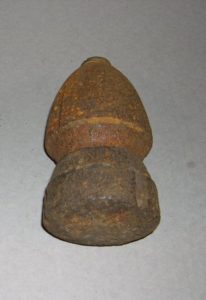
14-POUNDER HOTCHKISS SHELL, 1863
Iron. Gift of Warren Whittle, 1947
Captain William Harris, Senior Ordnance Officer, U.S. Ordnance Corps, reported on January 1, 1864:
“a small machine-shop was started which was used in reducing the caliber of Hochkiss (sic) shell for James 3.8-inch rifle guns to 3.67, after which they were fired from the 20-pounder battery commanded by Lieut. Samuel N. Benjamin. About 200 were thus prepared and found to answer satisfactorily…some of the shells thus prepared by the Ordnance Department were used with terrible effect as hand grenades upon the rebels in the ditch of Fort Sanders.” From the Official Records of the War of the Rebellion, Vol. 31
Lt. Benjamin himself reports lighting the paper fuses with his cigar and throwing the shells over the parapet with the words, “Watch out. Somebody might get hurt down there.” Ducloux Scrapbook, C. M. McClung Historical Collection, Knox County Public Library.
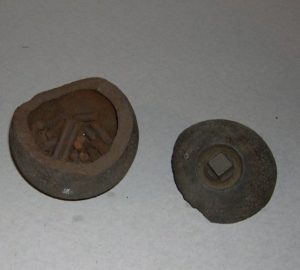
12-POUNDER SHELL WITH SHRAPNEL,1861-1865
Iron. Gift of Warren Whittle, 1947
Napoleons, smoothbore bronze cannons, fired 12-pounder shells like this one and other ammunition. The shell, with its 38 iron fragments, was designed to burst above the heads of infantry, showering them with shrapnel; this shell broke during transit.
Napoleons were inside Fort Sanders, and also in the Confederate field artillery commanded by Col. E. Porter Alexander, Capt. Poe’s old friend.
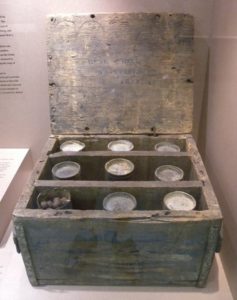
CASE OF 3-INCH HOTCHKISS CANISTER SHELLS, 1864-1865
Iron, lead, tin, white pine. Gift of Warren Whittle, 1947
Canisters are an excellent example of anti-personnel ordnance, having 27 small iron balls packed with sawdust inside a tin cylinder. On the morning of the attack, Lt. Samuel Benjamin, Co. E, 2nd U.S. Artillery, ordered his men to load three canisters and one powder charge in the guns, that is, triple-shotted. He knew they would only have time to fire once before the first charge of the enemy would be at the works.
The Indianapolis Arsenal shipped this case of canister sometime between February 1864 and the end of the war. Both the arsenal’s name and the name of its commanding officer, Capt. J. M. Whittemore, are stenciled on the other side of the case lid. The exterior side reads “Genl Carnes, Knoxville, Tenn.”
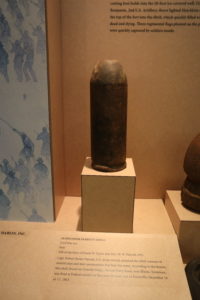
10-POUNDER PARROTT SHELL, Civil War era
Iron, Gift of the heirs of Frank W. Taylor and Mrs. W. W. Harrell, 1951
Capt. Robert Parker Parrott, U.S. Army retired, patented the rifled cannons of several sizes and their ammunition that bear his name. According to the donors, this shell, found on Gravelly Ridge, Nance’s Ferry Road, near Blaine, Tennessee, was fired at Federal cavalry in the area 20 miles east of Knoxville on December 16 or 17, 1863.

